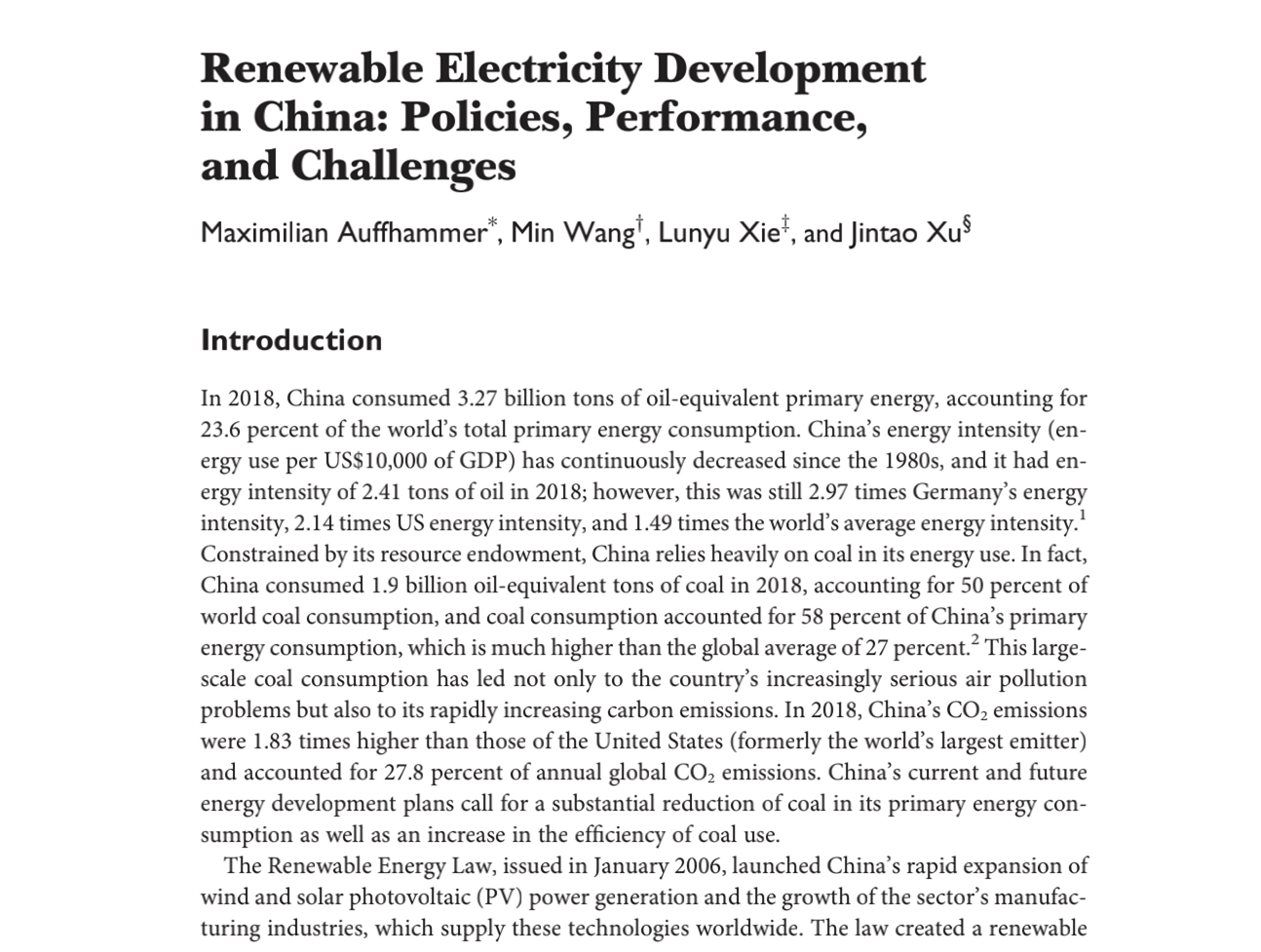Dr. Lunyu Xie recently had a paper published in the Review of Environmental Economics and Policy.The paper titled‘Renewable Electricity Development in China: Policies, Performance, and Challenges’, was coauthored with Maximilian Auffhammer from Department of Agricultural and Resource Economics, University of California–Berkeley, and NBER, Min Wang from China Center for Economic Research, National School of Development, Peking University, Jintao Xu from China Center for Economic Research, National School of Development, Peking University.

Introduction
In 2018, China consumed 3.27 billion tons of oil-equivalent primary energy, accounting for 23.6 percent of the world’s total primary energy consumption. China’s energy intensity (energy use per US$10,000 of GDP) has continuously decreased since the 1980s, and it had energy intensity of 2.41 tons of oil in 2018; however, this was still 2.97 times Germany’s energy intensity, 2.14 times US energy intensity, and 1.49 times the world’s average energy intensity.1Constrained by its resource endowment, China relies heavily on coal in its energy use. In fact, China consumed 1.9 billion oil-equivalent tons of coal in 2018, accounting for 50 percent of world coal consumption, and coal consumption accounted for 58 percent of China’s primary energy consumption, which is much higher than the global average of 27 percent.2This largescale coal consumption has led not only to the country’s increasingly serious air pollution problems but also to its rapidly increasing carbon emissions. In 2018, China’s CO2 emissions were 1.83 times higher than those of the United States (formerly the world’s largest emitter) and accounted for 27.8 percent of annual global CO2 emissions. China’s current and future energy development plans call for a substantial reduction of coal in its primary energy consumption as well as an increase in the effificiency of coal use.
The Renewable Energy Law, issued in January 2006, launched China’s rapid expansion of wind and solar photovoltaic (PV) power generation and the growth of the sector’s manufacturing industries, which supply these technologies worldwide. The law created a renewable energy development fund (funded through a renewable price surcharge on industrial and commercial electricity users) to subsidize renewable energy power generation and mandated that electric utilities procure renewable energy power generation. As a result, between 2006 and 2018, China’s total installed capacity of wind power increased from 2.07 to 185 GW, and its total installed capacity of solar PV power increased from 0.16 to 175 GW.3 In fact, China became the country with the world’s largest installed wind capacity in 2011 and the world’s largest installed solar PV capacity in 2015. In 2018, China accounted for 35 and 33 percent of global accumulated installed capacity of wind and solar PV power, respectively.
China’s renewable energy policy has led to two major problems. First, although the surcharge has been increased fifive times since 2006 to fifinance the country’s rapid renewable capacity expansion,4 the surcharge earnings have not kept pace with the increasing demand for subsidies, and the gap between the surcharge earnings and the subsidies continues to grow. In fact, this subsidy debt (the amount the government owes renewables investors) grew from ¥19 billion (approximately US$2.9 billion) at the end of 2014 to ¥293 billion (approximately US$45 billion) by the end of 2019 (Bloomberg 2020). Given the continued rapid growth in installed wind and solar power generation capacity, this subsidy debt is likely to continue to increase unless there is a policy reform. Second, according to the National Energy Administration (NEA; NEA 2018a), the national average curtailment rate (the ratio of curtailed electricity to total electricity generation) is high for wind and solar, reaching record highs of 17 and 10.3 percent, respectively, in 2016. Although the national average rate of wind and solar curtailment decreased to 7 and 3 percent, respectively, in 2018, it was still a serious problem in China’s northwestern provinces (NEA 2019a).5 As we will discuss, these high curtailment rates have been caused by several factors, including regional economic downturns, weak demand for electricity, stagnant power transmission grid construction, local government protection of local economies, and interprovincial power market barriers.
In this article, which is part of a symposium on China and the Environment,6 we review China’s wind and solar PV development and policies, examine why and how the subsidy debt and curtailment problems have arisen, and discuss additional policy reforms that are needed to support sustainable long-term renewable electricity development in China. We divide the history of China’s renewable electricity development into three stages. First, we discuss the early stage of development (before 2009 for wind and before 2011 for solar PV power), when the subsidies were limited. Then we examine the second stage, when there was large-scale development of renewables through large subsidies (2009–2017 for wind and 2011–2017 for solar PV power). Finally, we discuss the most recent stage (after May 2018) of renewables development, when the government’s policies generally shifted to competitive auctions to promote wind and solar PV power generation. We conclude with a summary and brief discussion of additional policy reforms to promote the future development of renewable energy in China.
Other information
Publication Date:2021
Journal:Review of Environmental Economics and Policy
Journal Issue: 15(2021)
DOI: https://doi.org/10.1086/715624
Read the paper here.